Free Courses Sale ends Soon, Get It Now


Free Courses Sale ends Soon, Get It Now



Copyright infringement not intended
Picture Courtesy: https://www.worldbank.org/en/region/afr/brief/the-kariba-dam-rehabilitation-project-fact-sheet
Context: Drought affected Lake Kariba in Zimbabwe, impacting both human communities and wildlife in the region.
Impact on Local Communities
Government Interventions
Lake Kariba

Must Read Articles:
Source:
|
PRACTICE QUESTION Q. Which two countries border Lake Kariba? A) Zambia and Zimbabwe B) Zambia and Malawi C) Zimbabwe and Mozambique D) Botswana and Namibia Answer: A |
© 2024 iasgyan. All right reserved